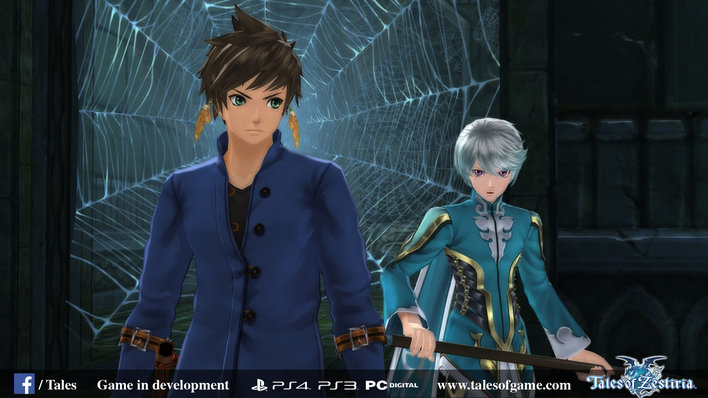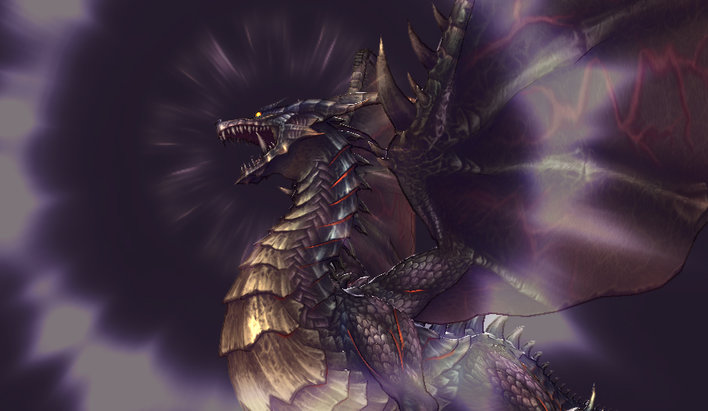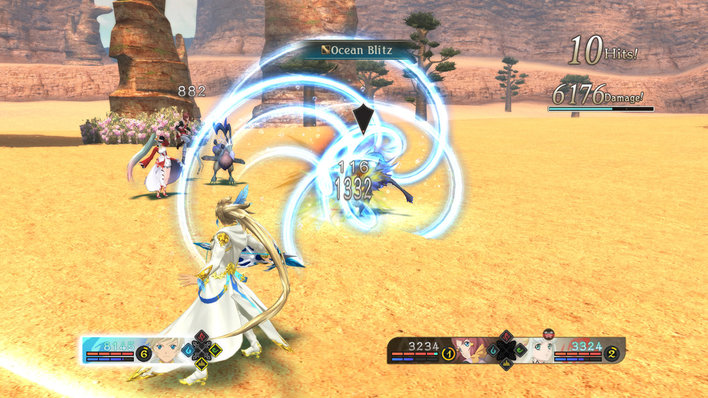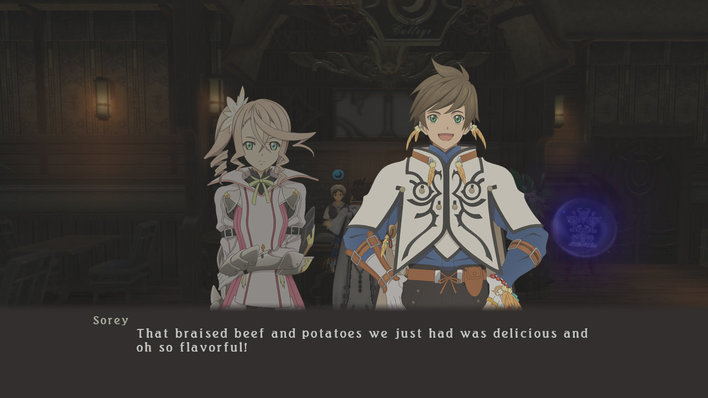As someone who regularly talks to themselves, we've lost count of the number of strange looks, confused faces and creeped out people we've come across (too right - Ed). Perhaps it wouldn't be so bad if we actually as talkative with other people as we seemingly are by ourselves, whether we're on our own chuntering to the cat, wandering around Tesco or telling an inanimate object to 'stay' - but as it stands, everybody tends to think you're a bit of a mental patient. But we think we've finally found someone who might understand our plight - the protagonist of the latest Tales of game, Sorey.

We're not liking the size of that spider web... Swish earrings, mind.
Sorey is a lone human who grew up in a village of spirit-like 'seraphim' beings - kind of like ghosts, only less creepy. A bit of an unusual existence, these seraphim can't actually be seen by most other humans, but main man Sorey can see them just fine (hence he looks like he's talking to himself). Unfortunately for you, all is not well with the rest of the world, however, as a mysterious force known as the 'malevolence' has been spreading, fed by mankind's negative emotions, causing famine, natural disasters and chaos. By what we can only imagine is a glorious coincidence, it turns out that because of his unique upbringing amongst the seraphim, Sorey alone has the power to become the 'Shepherd' - a figure of legend that it's been foretold will save humanity from the darkness that has befallen the world. So along with his accompanying band of seraphim friends, Sorey sets out on an adventure to take the fight to the darkness-infused 'hellion' enemies, and save humanity from it's dire fate at the hands of the Lord of Calamity, the source of all the malevolence in the world.
The people of Zestiria though are blissfully unaware of this entire plight. Unable to see the seraphim or the malevolent spirits, where Sorey sees a goblin-like hellion or a humongous snake-dragon beast, they simply see a poor boy turned to pick pocketing or a giant water spout. As such, Sorey finds himself both worshipped as a saviour and shunned as a loon in a silly costume in equal measure during his journey across the kingdom - after all, to outsiders, most of your party members are essentially invisible, so it looks like their legendary saviour, the Shepherd, is talking to himself. Add in two warring factions, both intent on using of Sorey's phenomenal cosmic powers for their own agendas, and you'll find most of the plot centres around Sorey and co's struggles as they try to tread the line between dispatching hellions and saving humanity, whilst trying to avoid the war as best they can. Because nothing creates excess hellions quite like a war.

If a seraphim totally loses themselves to the malevolence, they become a dragon.
Generally speaking, Tales of Zestiria plays much like it's umpteen predecessors - you and your party explore dungeons, forests and caves, talk to folks in towns and battle enemies as you work your way towards saving the world. With a slightly more medieval-ish theme to it, you'll spend a lot of time wondering the corridors of many an ancient ruin, solving simple puzzles along the way, whether it's pressing a series of pressure plates to open a door, lighting a number of torches or harnessing the power of wind to glide across a gap. Of course, it wouldn't be much of a role-playing game without plenty of battles either, and in that department Zestiria doesn't disappoint - it'll even see you facing off against humongous dragons too.
As with every new Tales of game, Zestiria's battle system is an evolution of it's predecessor, adding a few new features to the tried-and-tested button-mashing real-time battles we've come to know and love. Known as the Fusionic Chain Linear Motion battle system, it essentially lets Sorey channel the powers of his seraphim spirit friends to become an elementally-charged, more powerful version of himself. And he gets hair extensions to boot, just because. Different enemies have different elemental strengths and weaknesses, so you'll find yourself hot-swapping between companions and fusing with them, via the process of Armatization, to take them down as efficiently as possible. Not really a far cry away from Tales of Xillia 2's multiple weapon swapping mid-battle, it's familiar enough to pick up but different enough to keep things interesting.

Dat hairdo.
The other biggie about Zestiria's battles is that they now take place out in the open, on the field as you explore, rather than transitioning into a set, themed 'battle arena' of sorts, as per the previous games. It was a feature Bandai Namco seemed to big up back when the game was first announced, but to be honest, it doesn't really add or change a great deal - your battlefield is still bound by a circular perimeter that you can't leave, only now there may or may not be hills, rivers or corridor walls in the way of some of your attacks. But while the 'new' battles are neither here nor there, they do introduce a bit of a problem - without the confines of the set battlefields of the previous games keeping it in check, the camera can go a bit wild, particularly in more close-quarters areas like ruins and dungeons. It's not uncommon to find yourself with a close-up of a wall, or have the camera gyrate crazily momentarily as it gets caught in a corner - and neither is it unusual to find Sorey has been cut off the screen completely for a few seconds at a time. The camera problems aren't so widespread as to hurt the game majorly, particularly as Zestiria's default difficulty seems pretty forgiving, but if you're the sort that prefers to crank the difficulty up or take battles more tactically, it could end up being an annoyance .
But Sorey doesn't take on the Shephard's quest on his own, and joins forces with a number of others along the way. One of the first characters you'll meet is Alisha, a character that's like a more feminine version of Game of Throne's Brienne of Tarth - straight-laced and duty-driven, the princess knight has a strong sense of right and wrong, and leaves the party fairly early into the game to do her own thing. It was this decision that set the Japanese Tales of fandom on fire, with many claiming that Bandai Namco cut her out the story purely to profiteer off her extra downloadable 'Alisha's Story'. The way they reacted to her leaving, and replacement by the plucky Rose, you'd think they'd replaced her with the Lord of Calamity himself - but it sort of makes sense in the long run. You see, Rose, a member of the assassin's guild, is another human with a similar seraphim-sensing ability to our Sorey, allowing her to merge with them in battle too - something which Alisha could only dream of doing. As such, Rose and Sorey make a far better team than him and her predecessor, and Rose has a far more likeable personality to boot, coming across as way more fun-loving and friendly than Alisha ever did, although that's not to say Alisha is bad either. Also, Rose is scared of anything and everything, so we can totally relate!

As an assassin, Rose's weapon of choice is a pair of daggers.
As always, the mix of party members and the chemistry between them is a particular highlight. Outside of Alisha and Rose, you have your childhood friend and water seraph, Mikleo, whose constant arguments, banter and winding up of Sorey keep things from getting too serious, whilst the seraph responsible for turning you into the Shepherd, Lailah, is a bit doo-lally and random, particularly when conversation wanders onto topics she's sworn to not talk about. Earth seraph Edna meanwhile is a total emo, whose cutting sarcasm and hatred of humans is kind of at odds with her seemingly innocent and childlike appearance, while Dezel's driven by a vendetta against the Hellions that slayed his friend. Finally, wind seraph Zavied is the traditional skirt-chaser of the group, giving Sorey romantic 'advice' during their journey - and getting himself into trouble with the ladies too. Series staple 'skits' return too, which are random, cheesy and often entertaining side conversations between characters that cover everything from fusion basics to favourite foods to who has the biggest weapon, giving you more of an insight into everyone's personalities - and a giggle too.

As the Shepherd, Sorey always has his mind on important matters...
While we're on the subject of large weapons, Tales of Zestiria has one more unique trick up it's sleeve - the ability to fuse like-named items together to create new and more powerful ones with unique abilities attached to them. It's a little complicated but essentially, depending on which abilities you add, in which order, and alongside which others, you can create totally unique weapons that are way more powerful than anything you'd ever be able to buy in stores. Some effects require you to hunt down the adorable Normin creatures scattered around all over the world, who have the ability to imbue your weapons with unique abilities too - whilst acting as a kind of collectable for those of us of an OCD nature. Normin can also be sent to serve each area's Lord of the Land, a powerful seraphim that watches over different districts of the world, making it so defeated enemies drop items with the corresponding Normin's skill attached, making your weapon-fusing life much easier.
All in all, Tales of Zestiria is another stellar entry in the series, with it's funky new fusion battle system, likeable cast of characters and wealth of weapon customisation options - it's just a shame the camera sometimes seems to have a mind of it's own. For us it feels like a return for form for the series after the slightly disappointing Xillia games (yes, we went there), up there with the likes of Tales of Graces f and Tales of Hearts R - but if you're a fan of colourful Japanese role-playing games, then you can't go wrong with Zestiria.
Format Reviewed: Playstation 3

















